It was not until I lived in Portugal that I became intimate with little owls Athene. I could recognise their voices easily enough, but they always seemed to be inventing new sounds. Gradually I learned to live with their Latin temperament, and with the help of a comprehensive ‘dictionary’ (Exo & Scherzinger 1989), I eventually learned their language.
Once I was able to sort their calls into types, I was thrilled to find that I could distinguish two different little owl species by ear, both living in the Western Palearctic. The big surprise was that of the many possible taxa it was vidalii that was the odd one out. This is not an owl I need to sit five hours on a plane to go and visit, but one I have lived with in Britain (where it was introduced in 1842), Holland and Portugal. A new genetic study (Pellegrino et al 2014) recently confirmed a large genetic difference between this and the other European little owls, and clarified their distribution. Since A vidalii is the best known taxon in the English-speaking world, the familiar name Little Owl seems appropriate for it. All the others share a diagnostic battle cry, which several Mediterranean languages use to identify them. We will do the same, and group them together as Cucumiau A noctua.
Athene owl calls are highly volatile. Each one seems capable of morphing into others of higher and lower emotional intensity.
In the following account, the progression is from relative calm through increasing excitement to decisive action. The notes become shorter with each successive call type as they become more and more explosive. It helps to be familiar with these call-types in Little Owl before learning how they differ to varying degrees in Cucumiau.
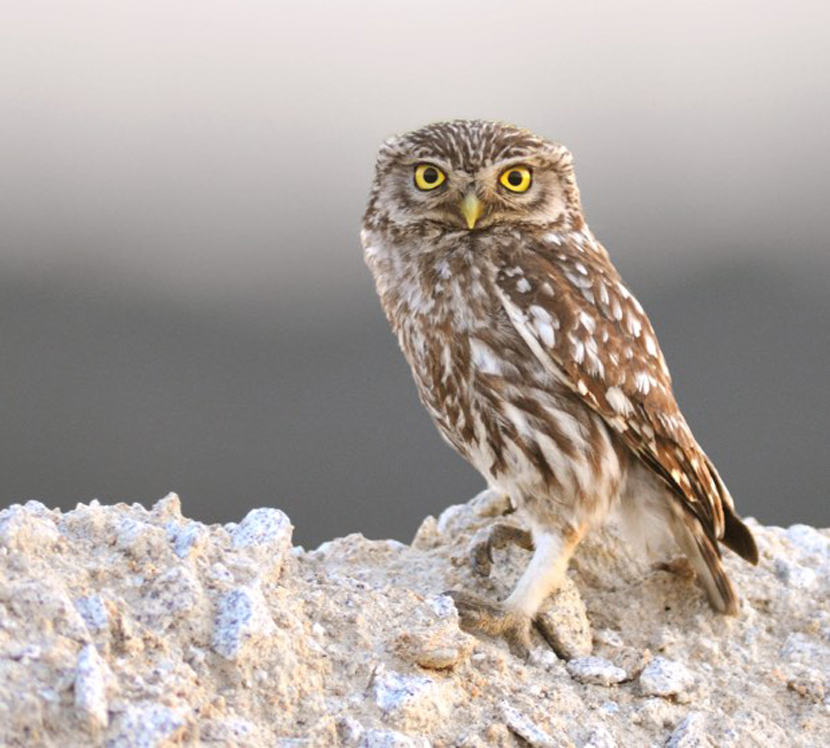
Little Owl Athene vidalii, Rosmaninhal, Idanha-a-Nova, Portugal, 28 June 2010 (René Pop)
Hearing a male Little Owl hooting his long, rising notes on a warm, windy night in late February (CD1-43), you would never suspect his fiery temper. By the light of a gibbous moon, he calmly surveys his small patch of Holm Oak Quercus ilex montado. Nearby there is a small, uninhabited cottage. A couple of donkeys keep the grass cropped under the scattered trees. The nearest inhabited building is 2 km away, so for once there are no dogs barking. Only a croaking Natterjack Toad Bufo calamita and some rustling leaves put the owl in his living context.
In early spring, males hoot day and night with a strong peak at dusk and a lesser one at dawn. A bout of hooting may last several minutes or longer. As it progresses, the overall pitch and volume gradually rise. When the male reaches the highest pitch he can hoot loudly, the hoots gradually level out. Females can also hoot, but only in short series of up to about five lower-pitched, shorter hoots (Exo 1984). In CD1-44 both members of a pair are hooting, the much quieter one being the female. She only starts in earnest at 0:14 and then her series consists of just three short hoots.
CD1-43: Little Owl Athene vidalii Rosmaninhal, Idanha-a-Nova, Portugal, 20:20, 25 February 2010. Hooting of a male, with others hooting and giving excitement calls in the distance. Background: Natterjack Toad Bufo calamita. 100225.MR.202044.21
CD1-44: Little Owl Athene vidalii Rosmaninhal, Idanha-a-Nova, Portugal, 19:26, 25 February 2010. Hooting of a male, with quiet excitement calls of female changing into hooting from 0:14. Background: Natterjack Toad Bufo calamita. 100225.MR.192642.30
Athene owls are unusual in preferring open habitats and not being dependent on forests. Although they often breed in tree holes, at some point in their evolution they started to recognise cavities in cliffs and piles of rocks as alternatives. This allowed them to colonise arid and barren areas where they were often the only species of owl. The inflections in Little Owl hooting may have evolved as a consequence. Without forest resonance to extend a sustained, even pitch beyond its length, there is little advantage in producing one. Instead, Little Owls can afford to distinguish themselves with a rising hoot.
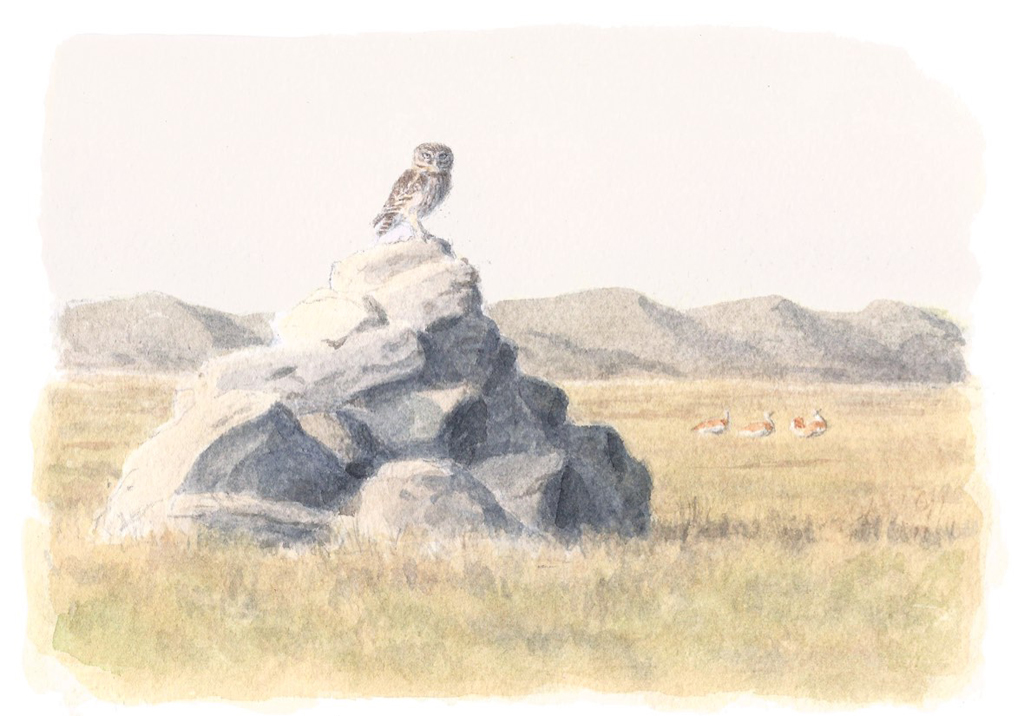
Håkan Delin
The Little Owls that I know best breed around Rosmaninhal in eastern Portugal. The village is full of owls, but recording them involves negotiating an acoustic minefield. When one dog gets a fright, it may be 10 minutes before the wave of unrest has made it around the village. Otherwise it is a quiet place, with almost no traffic at night. The human population is mainly elderly, and at a guess I’d say that over half of the houses are unoccupied.
In early March, a 500 m walk along the northern fringe of the village could take you through around six Little Owl territories. In the orange glow of the streetlights, these not-so-sharp-sighted owls are able to stay active all night long. I recorded CD1-45 underneath a lamppost where one male liked to hoot. It shows how Little Owl calls ‘grade’ into one another. Here, hooting emerges from two much quieter call types.
CD1-45: Little Owl Athene vidalii Rosmaninhal, Idanha-a-Nova, Portugal, 23:23, 3 March 2010. The first call is half ‘contact call’ and half ‘beckoning call’. After 0:17 there is a contact call, then the bird starts to hoot loudly. Contact calls play a role in close range communication between pair members during the whole year. Beckoning calls are single notes similar to hooting but much quieter and usually shorter. They are used to reassure or appease. Contact and beckoning calls are often heard in association (Exo & Scherzinger 1989). Background: Barbary Dove Streptopelia risoria. 100303.MR.232312.11
At the other extreme, hooting often leads into higher-pitched ‘excitement calls’ (Exo & Scherzinger 1989). Their contour is highly variable but always rises before it falls. A series may be fairly long, but excitement calls are by nature unstable. Often they escalate into aggressive song, alarm calls or cackling, depending on the course of the interaction. Alternatively, things may calm down until all we hear is subdued hooting. In CD1-46 it is 02:40 in the morning. Except for one or two insomniacs, the dogs are asleep, but goat bells are still tinkling. The Little Owls are wide awake and socialising. At least six different individuals give excitement calls at high intensity. Over the course of five minutes a Mexican wave of these excitement calls passed slowly from right to left as each pair tested its neighbours.
CD1-46: Little Owl Athene vidalii Rosmaninhal, Idanha-a-Nova, Portugal, 02:40, 18 March 2012. A chorus of excitement calls involving at least six individuals, part of a 5-minute ‘Mexican wave’. Background: Southern Tree Frog Hyla meridionalis and Iberian Green Frog Pelophylax perezi. 120318.MR.024017.12
Aggressive song, the best-known sound in Little Owl’s large repertoire, consists of a burst of particularly shrill excitement calls: MIAU…MIAU…MIAU…etc. Because so much energy is required to produce such an outburst, it never lasts very long. Very often, both pair members participate as a duet, triggering their neighbours as well. In CD1-47, at least four birds are performing aggressive song, with others also calling in the background. After a couple of beckoning calls, the pair in CD1- 48 perform shrill aggressive song as a duet. This gives way to a long series of more tempered excitement calls.
CD1-47: Little Owl Athene vidalii Rosmaninhal, Idanha-a-Nova, Portugal, 22:45, 6 March 2009. Aggressive song of at least four individuals. Background: Southern Tree Frog Hyla meridionalis and Iberian Green Frog Pelophylax perezi. 090306.MR.224526.30
CD1-48: Little Owl Athene vidalii Rosmaninhal, Idanha-a-Nova, Portugal, 22:25, 6 March 2009. Aggressive song of a pair, gradually giving way to excitement calls. Background: Southern Tree Frog Hyla meridionalis and Common Barn Owl Tyto alba. 090306.MR.222541.01
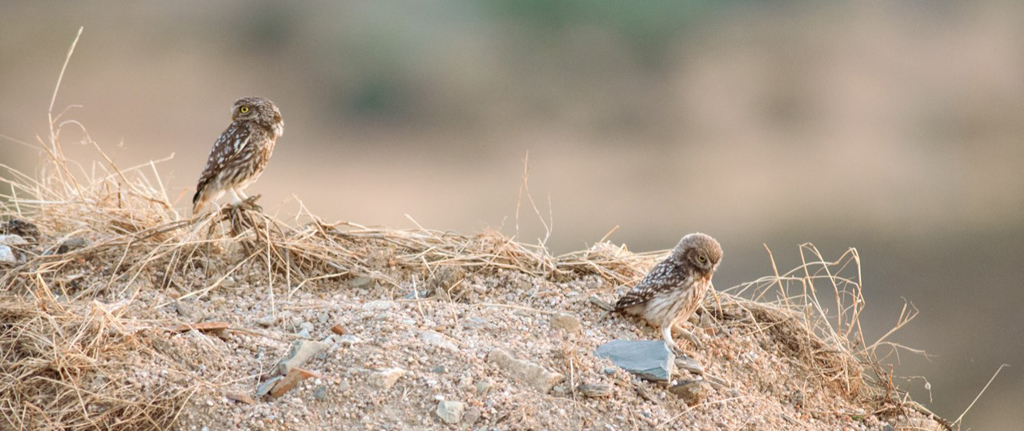
Little Owl Athene vidalii, adulte (left) and juvenile, Rosmaninhal, Idanha-a-Nova, Portugal, 28 June 2010 (René Pop)
Aggressive song is used throughout the year and plays a prominent role during autumn when young birds are dispersing and competing with adults for territories. When I record night migration in October and November, I often hear it during calm nights. There are peaks at dawn and dusk, especially in areas of high population density. CD1-49 was recorded in autumn at a disused monastery perched high above the sea, about 75 minutes before sunrise.
CD1-49: Little Owl Athene vidalii Cabo Espichel, Sesimbra, Portugal, 06:00, 11 October 2010. Aggressive song at dawn in autumn. Background: the sea. 101011. MR.060052.12
Sometimes when discovering and chasing off intruders, aggressive song escalates into the ‘alarm call’ (Exo & Scherzinger 1989). In Little Owl this usually consists of at least two notes. The complete call may be given in isolation or repeated several times. The ‘alarm call’ may also be used to warn family members about potential predators. If young are begging nearby, they immediately fall silent.
The two-note alarm calls in CD1-50 were given by an adult accompanying fledged juveniles, when it became nervous about my presence. CD1-51 illustrates the less common single-note alarm call, given by a surprised owl as it flew round the corner of the clifftop monastery.
CD1-50: Little Owl Athene vidalii Rosmaninhal, Idanha-a-Nova, Portugal, 21:57, 15 June 2009. Two-note alarm calls of an adult accompanying fledged juveniles. Background: Iberian Green Frog Pelophylax perezi and juvenile humans Homo sapiens. 090615.MR.215752.01
CD1-51: Little Owl Athene vidalii Cabo Espichel, Sesimbra, Portugal, 06:32, 29 September 2009. Single-note alarm calls in autumn when surprised by recordist. 100929.MR.063226.01
Cackling is Little Owl’s most explosive call. It conveys extreme excitement in a variety of situations that include disturbances near the nest, encounters with enemies (I once heard it when a barn owl suddenly appeared), territorial disputes and squabbles with partners. In CD1-52 the caller arrives from the left and completes the series from a perch. Cackling is in some ways an escalation of the alarm call and structurally related to it. Unlike the alarm call, which contains a warning, cackling usually accompanies decisive action. Of all Little Owl sounds, this is the one most often given in flight. It may ring out quite unexpectedly or mark the end of a longer interaction. We can hear it at any time of year.
CD1-52: Little Owl Athene vidalii Rosmaninhal, Idanha-a-Nova, Portugal, 06:05, 26 February 2010. Cackling in flight, then perched. Background: Red-legged Partridge Alectoris rufa and Woodlark Lullula arborea. 100226.MR.060516.01
CD1-53 shows Little Owl social dynamics at their most fluid. All of the loud call types that we have covered so far are included, except for cackling. The recording can serve as a little test: for you to see whether you can pick them all out, and for me to find out whether I have described them adequately.
CD1-53: Little Owl Athene vidalii Rosmaninhal, Idanha-a-Nova, Portugal, 23:29, 5 March 2009. Calls of a pair perched on a lamppost, interacting with their neighbours. The most prominent sounds include hooting, alarm calls, aggressive song, beckoning calls and excitement calls. Background: Common Barn Owl Tyto alba. 090305.MR.232940.11
After several years of recording Little Owls in Rosmaninhal, I thought I knew their sounds well, but I had never actually recorded at a nest. In an isolated small ruin near my home northwest of Lisbon, I found one hidden in a corner of the loft. To my amazement, almost every sound I recorded there was new to me. I shouldn’t have been so surprised. Exo & Scherzinger’s (1989) comprehensive account listed at least 22 clearly separate call types that in turn evolved from five basic originals.
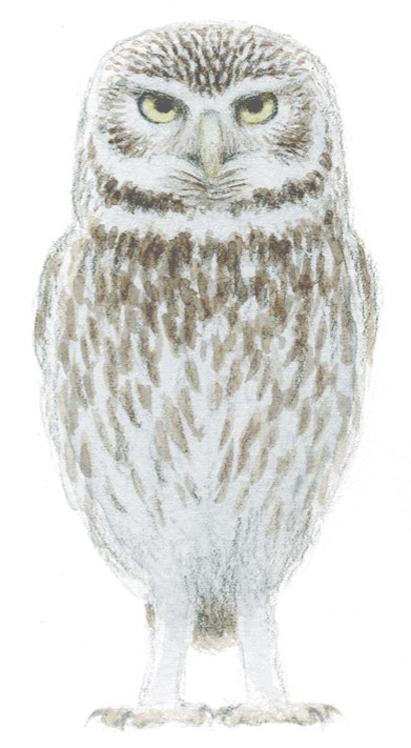
Håkan Delin
The first surprise was that during the last couple of weeks before egg-laying, most close-range communication between the partners was with husky, highly variable soliciting calls that I had hardly noticed before. In CD1-54, a male and female are both using these, a few days before the start of egg-laying. The context is courtship feeding. This ritual not only cements the pair bond but also establishes how much food is available in the territory As for the male, he uses this call to placate his partner when he needs to come close.
CD1-54: Little Owl Athene vidalii Galamares, Sintra, Portugal, 03:23, 11 April 2012. Soliciting calls of male and female, with the female giving longer calls on the left (‘begging-snoring’ in Exo & Scherzinger 1989). 120411.MR.032357.02
The female of my local pair laid eggs in mid-April. During the three weeks prior to this, the pair seemed to use almost all the quieter sounds in their vocabulary. In the lead up to copulation they used a great variety of sounds, most of them very quiet. Only the final, high-pitched twitter would have been audible more than a few metres away. CD1-55 illustrates the whole call sequence before and after copulation.
CD1-55: Little Owl Athene vidalii Galamares, Sintra, Portugal, 03:06, 3 April 2012. Call sequence leading to copulation. The rising, yelping calls belong to the female while the chugging and beckoning calls are the male, as well as the copulation twitter at 0:23. The female gives a few husky soliciting calls at the end. 120403. MR.030646.03
The month of incubation was very quiet. After hatching, the young were virtually inaudible for the first few days. Even with the microphones just 2 m away, they barely registered. In CD1- 56, the adult male arrives on the right, then scampers across the floorboards to the nest. I believe he is probably the one giving a single soliciting call as he hands over prey to the female, while she then uses a long series of staccato ‘feeding calls’ to encourage her nestlings to eat.
CD1-56: Little Owl Athene vidalii Galamares, Sintra, Portugal, 03:52, 18 May 2012. Male arrives at nest and scampers across the floorboards. Then there is a single soliciting call (the male?) and a long series of feeding calls (the female?). Two or three tiny nestlings call faintly in the background. 120518.MR.035220.02
By the time Little Owls fledge, an alert birder passing close by can hardly fail to hear them. In late June, begging calls can be heard all round Rosmaninhal. The challenge is to separate those of Little from the rather similar begging calls of Common Barn Owl. Little Owls beg much more quietly, so confusion is only possible if we misjudge the distance. This quietness also makes them challenging to record. I finally succeeded one early July night when a juvenile landed just 3 m away, apparently oblivious to me (CD1-57). When I gently lifted my binoculars it flew off with a single alarm call.
CD1-57: Little Owl Athene vidalii Rosmaninhal, Idanha-a-Nova, Portugal, 00:57, 4 July 2009. Begging calls of a fledged juvenile, then a single alarm call when it noticed the recordist. Background: a singing dog! 090704.MR.005712.01
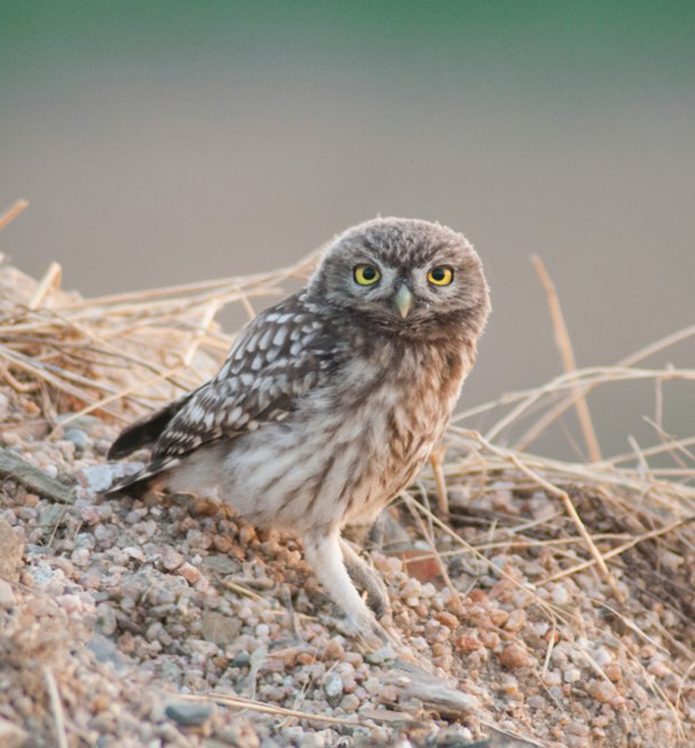
Little Owl Athene vidalii, juvenile, Rosmaninhal, Idanha-a-Nova, Portugal, 28 June 2010 (René Pop)
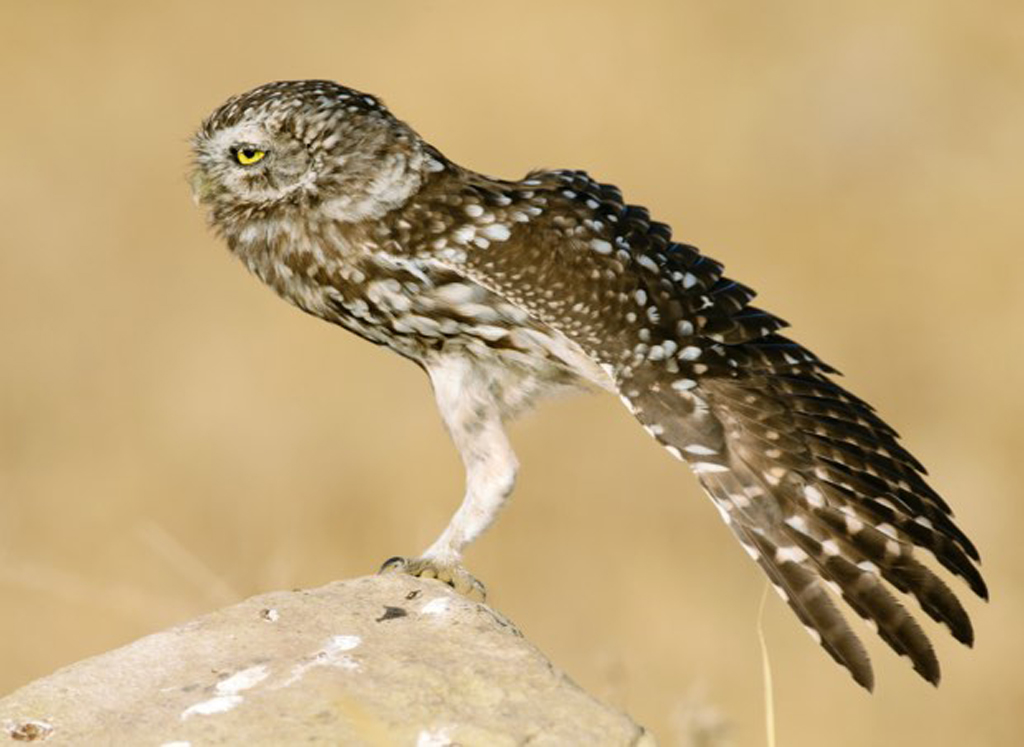
Little Owl Athene vidalii, Tahivilla, Andalucia, Spain, 9 September 2012 (Dick Forsman)
Juveniles gradually increase their activity radius, but return to their natal territory several times before finally severing ties with their parents in late September or early October. By the beginning of November, most have settled somewhere else. A typical dispersal distance for juveniles is less than 20 km. Fewer than 10% disperse over 100 km (van Nieuwenhuyse et al 2008). Occasionally, Little Owls from the introduced British population have headed out across the Irish Sea, colonising the island of Skomer, plundering British Storm Petrels Hydrobates pelagicus on Skokholm (Alexander 1935), and occasionally straggling to the Isle of Man and the east coast of Ireland (Glue 2002).
Such long distance movements are exceptions that highlight a general truth. Owls of the genus Athene are, on the whole, rather sedentary. There is none of the continent-wide mixing of genes so typical of Tengmalm’s Owl Aegolius funereus. Being more sedentary allows them to adapt to regional conditions. In the past, there several species evolved on Mediterranean islands. A angelis (Mourer-Chauviré et al 1997) lived on Corsica and Sardinia, A trinacriae (Pavia & Mourer-Chauviré 2002) was a contemporary of the giant barn owls and dwarf elephants of Sicily, A cretensis lived on Crete (Weesie 1982), and A vallgornerensis has recently been described from Mallorca (Guerra et al 2012).
With this in mind, it should not be so surprising that there are still two species surviving. The real surprise is that it has taken so long to learn how to tell them apart.
